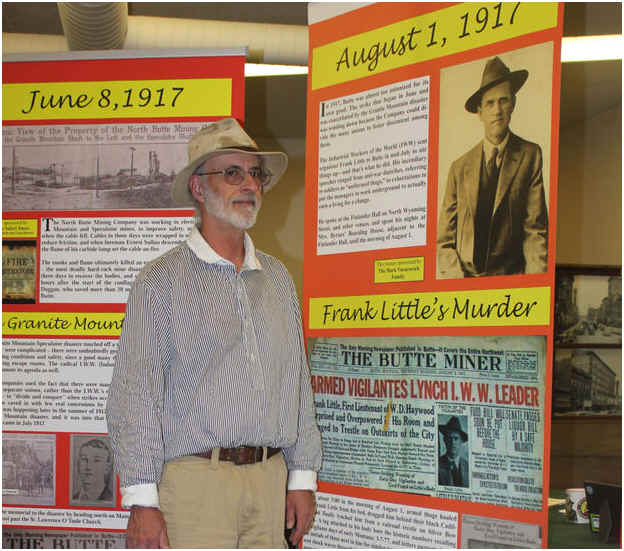|
In
1917, the IWW sent organizer Little to Butte in mid-July “to stir
things up,” as the Little-dedicated banner reads. The action came on
the heels of a strike following the Granite Mountain mine disaster.
Little’s
“incendiary speeches ranged from anti-war diatribes, referring to
soldiers as ‘uniformed thugs,’ to exhortations to put the managers
to work underground to actually earn a living for a change,” as
reported in the exhibit.
Little
spoke at the Finlander Hall on North Wyoming Street, among other venues.
He lived at Mrs. Byrnes’ Boarding House adjacent to the Finlander
until Aug. 1, 1917 — a fateful day.
About
3 a.m., the story goes, armed thugs hauled Little from his bed, dragged
him behind their black Cadillac, and lynched him from a railroad trestle
on Silver Bow Creek.
A
tag on his body bore the 3-7-77 historic numbers reminiscent of the
Montana vigilantes and initials of those supposedly next in line for the
same treatment.
|
“His
brutal murder sent shock waves through the labor movement nationally,”
reads the banner.
Reportedly,
his funeral procession drew 12,000 people — the largest contingent of
mourners in Butte at that time. About 2,500 marchers accompanied his
coffin as it was paraded through Uptown streets.
At
first the union planned to transport his body back east but eventually
decided “to bury Frank Little on the fighting ground of Butte.”
His
well-tended grave is in the pauper section of Mountain View Cemetery,
said Gibson.
“The
Anaconda Company’s control of Butte was such that no arrests were ever
made in Little’s murder. It is impossible to know for sure today, but
the most likely agents of his death were members of the Butte Police
Department, acting under orders from the Anaconda Company,” reads the
center banner.
|

Butte
historian and tour guide Dick Gibson, pictured this week, peruses the
Frank Little banner exhibit at Butte Labor History Center, 49 W. Park
St. The museum celebrates the 98th anniversary of Frank Little’s
murder on Saturday, Aug. 1, with reduced admission fees, reenactments,
and a documentary based on union organizer Little, “An Injury to
One.” The center is open Tuesday through Saturday from 10 a.m. to 4
p.m.
|
Comments:
Ninety-eight
years to the day on Saturday, Aug. 1, 2015 the young Butte Labor History
Center will mark the anniversary of union leader Frank Little’s
murder.
Open
in June, the center at 49 W. Park St. displays 11 vertical banners
depicting union labor history in Butte. The museum is slowly filling
with a wealth of union exhibits chronicling up to 50 unions.
“We’re
marking the day by having a discounted admission day,” said Dick
Gibson, BLHC board member and local historian. Cost will be $2 for
adults and free for kids age 6 to 14 if accompanied by an adult.
Gibson,
who wrote “Lost Butte Montana” and whose online blogs educate
amateur and professional historians alike, will twice reenact Frank
Little’s speeches to the Industrial Workers of the World to the
union-curious — once at 1:30 p.m. and again at 2:30 p.m. at the
center.
Two
showings of the Frank Little documentary, “An Injury to One,” follow
in the tiny but inviting 15-seat theater in the back of the center. The
2002 film is directed, produced and shot by Travis Wilkerson.
Praised
by the New York Sun as “Passionate, persuasive and beautifully
designed,” the film is described as “an experimental documentary
exploring the turn-of-century lynching of union organizer Frank Little
in Butte, Montana.”
|
![]()